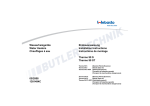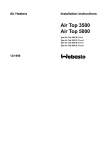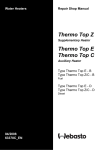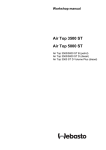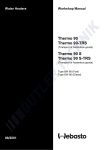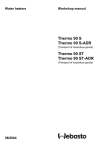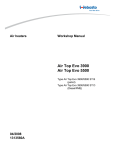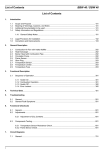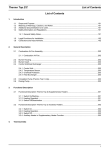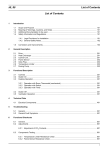Download Webasto Thermo 90 S-TRS Operating instructions
Transcript
Water Heaters Installation Instructions Thermo 90 Thermo 90-TRS Thermo 90 S Thermo 90 S-TRS (Transport of hazardous goods) Type BW 80 (Petrol), Type Thermo 90 S B (Petrol) Type DW 80 (Diesel), Type Thermo 90 S D (Diesel) Operating Instructions must be read before attempting to start up the heater. 4/1997 Thermo 90 / Thermo 90 S Table of Contents Page Installation Instructions 1 Legal Provisions for Installation 1 Installation 2 Installation Example 3 Connection to the Vehicle’s Cooling System 4 Fuel Supply 4 Fuel Lines 6 Metering Pump 6 Combustion Air Supply 7 Exhaust Pipe 7 Electrical Connections 8 Circuit Diagrams 10 Initial Operation 17 Malfunctions 18 Technical Data 20 Variants 21 Template for heater mounting bracket 23 Webasto Service Phone Line 25 I Thermo 90 / Thermo 90 S Installation Instructions Legal Provisions for Installation For testing the heater in accordance with articles 19, 20 oder 21 StVZO the following regulations are primarily to be observed (§ 22 a StVZO): NOTE: These provisions are binding within the scope of the StVZO (German Road Licensing Regulations) and should also be observed in countries where no special locally applicable regulations are in effect! Within the scope of the StVZO (German Road Licensing Regulations) “General Design Certifications” have been granted by the Federal Office for Motor Traffic for the Thermo 90 water heater with the following marks of approval: ~S231 for Thermo 90 heaters Petrol type BW 80 ~S232 for Thermo 90 heaters Diesel type DW 80 and for Thermo 90-TRS heater Diesel type DW 80. ~S299 for Thermo 90 S heaters Petrol type Thermo 90 S B ~S298 for Thermo 90 S heaters Diesel type Thermo 90 S D and for Thermo 90 S-TRS heaters Diesel type Thermo 90 S D The installation of the heaters must be performed in accordance with these Installation Instructions. The installation must be checked a) upon the homologation of the vehicles in accordance with § 20 StVZO b) upon any individual test in accordance with § 21 StVZO, or c) upon any examination in accordance with § 19 StVZO by a registered expert or examiner for motor traffic, an expert for automotive vehicles, or any other authorised official, in accordance with paragraph 7.4a of Appendix VIII to the StVZO and in the case of item c) the proper installation must be certified on the approval certificate contained on the design certification stating the following: - vehicle manufacturer - vehicle type and - vehicle identification number The effectiveness of the design certification (homologation) is dependent on this certificate. The approval certification is to be kept in the vehicle. The year of the initial operation must be durably marked on the type plate of the heater by the installer by removing the years that do not apply. Extracting the combustion air from the interior of the vehicle is not permissible. The discharge opening of the exhaust pipe must point upward, sideways or, in the case of routing the exhaust pipes along the underside of the bottom vehicle, it must be located near the lateral or rear edge of the driver’s cab or vehicle. Exhaust pipes must be so routed that the possibility of exhaust fumes entering the interior of the vehicle is remote. The functioning of any parts of the vehicle essential for its operation must not be impaired. main unaffected by torsional stresses in the vehicle, engine movement and the like. They must be protected against mechanical damage. Fuel-carrying parts must be protected against excessive heat and must be arranged such that any dripping or evaporating fuel can neither collect nor be ignited by hot components or electrical equipment. The heater must not be installed in rooms occupied by persons. The operating state of the heater at any given time – at least an indication as to whether it is “on” or “off” – must be easily recognizable. Webasto will not assume any liability if the installation instructions and the notes contained therein are not observed. The same applies to improperly performed repairs or those where others than genuine replacement parts have been used. In those cases, the heater’s General Design Certification and thus the General Operating Permit (homologation) will be invalidated as a consequence. The openings of the combustion air inlet and exhaust gas outlet must be so designed that a spherical object of 16 mm in diameter cannot be introduced. Electric lines, switchgear and control gear of the heater must be so arranged in the vehicle that their proper functioning cannot be impaired under normal operating conditions. For the routing of fuel lines and the installation of additional fuel tanks articles 45 and 46 StVZO are to be adhered to. The most important excerpts therefrom are as follows: Fuel lines must be designed in such a way that they re- Use of the Water Heaters The Webasto Thermo 90 water heater in conjunction with the vehicle heating system is designed to provide the following features: - heating the driver’s cab, - de-frosting the vehicle’s windscreen as well as - preheating of water-cooled engines. The water heater operates independently of the vehicle’s engine and is connected to the cooling system, the fuel system and the electrical system of the vehicle. 1 Thermo 90 / Thermo 90 S Installation Thermo 90 5 3 CAUTION: - The legal provisions on page 1, relating to the installation of the heater, must be observed - When installing the Thermo 90-TRS in vehicles designed for the transport of hazardous materials the requirements laid down in TRS 002 and TRS 003 (Technical Guidelines relating to the ordinance of transporting hazardous goods on the road) must be fulfilled in addition to those of the StVZO. Combustion air inlet Exhaust gas outlet Fuel inlet Coolant inlet Coolant outlet 1 2 3 4 5 Combustion air inlet Exhaust gas outlet Fuel inlet Coolant inlet Coolant outlet 4 - If the water heater is to be operated in a separately installed heating system, it is mandatory that the installation drawing be submitted to Webasto for approval prior to installation. NOTE: The different vehicle-specific installation conditions should be taken into account. 1 2 3 4 5 2 1 Thermo 90 S 5 3 Installation Location The heater should be installed at a level as low as possible so as to ensure automatic venting of the heater and the circulating pump. This is of special importance as the circulating pump is not of the self-priming type. 4 1 Fig. 2: 2 Dimensions of the Heater Type Plate Fig. 1: 2 Installation Position T90 / T90S The type plate must be located in a place where it is protected against damage and be easily accessible once the heater has been installed (or else, a type plate duplicate is to be used). The years not applicable are to be removed from the type plate. Thermo 90 / Thermo 90 S cable harness fuel line exhaust pipe water circuit without non-return valve Fig. 3: with non-return valve and thermostat Installation Examples for the Thermo 90 / Thermo 90 S Heater Legend of Fig. 3 1 Heat exchanger of vehicle heating system 2 Switch for vehicle heating fan 3 Relay for vehicle fan 4 Digital timer 5 Fuse bank in vehicle 6 Non-return valve with leakage hole 7 8 9 10 11 12 13 T-piece Vehicle engine Heater Circulating pump Water pump Radiator Regulating valve 14 15 16 17 18 19 Exhaust silencer Metering pump Combustion air intake pipe Thermostat Electronic control unit Control unit (alternative installation location of Thermo 90 S) 3 Thermo 90 / Thermo 90 S Connection to the Vehicle Cooling System Fuel Supply In the case of thermostat circuits only thermostats that open at temperatures < 65°C should be used. Fuel is drawn from the vehicle fuel tank or from a separate fuel tank. The heater is connected to the vehicle cooling system in accordance with Fig. 3. The amount of coolant in the cooling system should be at least 6 liters. In principle, only the water hoses supplied by Webasto should be used. If this is not the case, the hoses must at least comply with the requirements of DIN 73411. The hoses are to be routed without any kinks and – for proper venting – in an upward pitch, if possible. Hose connections must be secured against slipping off by means of hose clamps. The values relating to the permissible pressure at the fuel extraction point can be taken from the Table below. NOTE: The hose clamps must be tightened to a torque of 4 Nm. Before the heater is started up for the first time or after the coolant has been replaced, it must be ensured that the cooling system is properly bled. Heater and piping should be so installed that permanent self-bleeding of the system is ensured. permissible fuel feed height H (m) at max. permissible overpressure (bar) in fuel line 0.00 0.2 1.00 0.11 2.00 0.03 permissible fuel suction height S (m) at max. permissible underpressure (bar) in fuel tank 0.00 -0.10 0.50 -0.06 1.00 -0.02 Proper bleeding action can be recognized by the nearly silent operation of the circulating pump. Insufficient bleeding can result in tripping the resettable temperature limiter. l1 + l2 ≤ 10 m l1 ≤ 1.2 m l2 ≤ 8.8 m Fig. 4: 4 Fuel Supply Thermo 90 / Thermo 90 S Vehicles with Diesel Engines Vehicles with Petrol Engines Plastic tank Fuel must be drawn from the fuel tank or a separate tank (see Figs. 5, 6 and 7). When fuel is supplied from a separate tank, any pressure-related influence can be excluded. In the case of carburettor or injection engines equipped with return lines, the heater’s fuel system is to be integrated in the return line. In the case of carburettor engines without return line, the fuel circuit of the heater is to be integrated in the flow line between the vehicle’s fuel tank and pump. Fuel extracting device Sealing ring ANNOTATION A fuel flow line can usually be identified by the in-line fuel filter. Sealing ring Fig. 6: Fuel Extraction From the Plastic Tank (Extraction via Tank Drain Plug) Tank fitting Hole Pattern NOTE: If the vehicle’s fuel system is equipped with a vapour separator, fuel extraction is to take place upstream of same. For fuel extraction from flow or return lines it is mandatory that the special Webasto fuel pickup (see Fig. 8) be used. The fuel pickup is to be so mounted that any air or gas bubbles that may form are automatically discharged toward the tank (see Fig. 8). Air or gas bubbles in the fuel line of the vehicle can form if there is a leak in the vehicle’s carburettor or fuel pump or in the case of ambient temperatures exceeding the vaporizing temperature of the fuel. Fig. 5: Fuel Extraction From the Plastic Tank (Extraction via Tank Fitting) Fig. 7: NOTE: After tank extracting device has been cut to length by sawing, remove any burr and metal chips from cut edge. * Webasto Tank Extracting Device Fuel should not be extracted from within the vicinity of the engine as gas bubbles are likely to form in the lines owing to the heat radiating from the engine which may result in malfunctions in the heating operation. tank extracting device only to be used with metal fuel tanks NOTE: The fitting must be made of sheet metal! 5 Thermo 90 / Thermo 90 S Fuel Lines correct Only steel, copper and plastic pipes made of plasticized, light-resistant and temperature-stabilized PA 11 or PA 12 (e.g. Mecanyl RWTL) in accordance with DIN 73378 may be used. NOTE: Do not cut Mecanyl lines using a side cutter. to engine from tank to metering pump Fig. 8: Webasto Fuel Pickup If the heater is installed in vehicles equipped with injection systems it is therefore to be determined whether the fuel pump is mounted inside or outside the tank. Where the fuel pump is located inside the tank, fuel may only be extracted from the return line in which case it must be ensured that the return line extends almost to the bottom of the tank and that it is not closed by a nonreturn valve. Failing this, the return pipe can be extended. Where the fuel pump is mounted outside the tank, the connection to the fuel system can be accomplished between the fuel tank and the fuel pump. 6 clamp incorrect bubble As in the majority of cases it is not possible to route the lines in a continuous upward pitch, the inside diameter must not exceed a given dimension. If the inside diameter equals or is greater than 4 mm, air or gas bubbles accumulate which result in malfunctions if the lines sag or are routed in a downward pitch. When the diamters shown in Fig. 4 and 8 are used, you can be sure that no unwanted bubbles will form. Fig. 9: The lines leading from the metering pump to the heater should not be routed in a downward pitch. Metering Pump with Damper To prevent the fuel lines from sagging, freely suspended lines must be secured. Mounting should be performed in such a manner that the lines are protected against flying stones and thermal influence (exhaust pipe). bubble Pipe/Hose Connection The metering pump is a combined delivery/metering and shutoff system and is subject to certain installation criteria (see Figs. 4, 10 and 11). Installation Location Connecting 2 Pipes Using a Hose The proper connection of fuel lines using a hose is shown in Fig. 9. Check for leakage! Prior to installing the metering pump it must be ensured that the maximum pressure prevailing at the fuel extraction point is less than 0,2 bar. It is recommended that the metering pump be installed in a location which is sufficiently cool. On no account must the permissible ambient temperature at any given operating stage be in excess of + 20 °C in the case of petrol, and + 40°C in the case of Diesel variants. Metering pump and fuel lines must not be located within the radiation range of hot vehicle parts. If necessary, a radiation protection is to be provided. The preferred installation location is near the tank. Thermo 90 / Thermo 90 S 12-volts and 24-volts - Petrol and Diesel Installation and Mounting The combustion air inlet must not be located above the exhaust gas outlet. The metering pump is to be attached by vibration-damping suspension. The installation position is restricted in accordance with Figs. 10 and 11 in order to ensure sufficient selfventilation. preferably 15°-90° Fig. 10: NOTE: If it is not possible to route the combustion air line in a downward pitch, a ø 4mm water drain hole is to be provided at the lowermost point. Fuel Filter If dirt in the fuel must be reckoned with, only Webasto filter, order no. 487 171, should be used. Filter is preferably to be installed in vertical position, where this is not possible, it may also be installed horizontally (installation position 0°90°). Direction of flow to be observed!. Metering Pump Installation Position and Mounting 0 - 90° 12-volts and 24-volts - Diesel only When the heater is installed in the vicinity of the vehicle tank in a common installation space, combustion air must be drawn in from the outside of the vehicle and the exhaust gas be discharged to the atmosphere. Lead-through openings must be splash-proof. If the heater is located in an enclosed installation housing, a ventilation opening of at least 6 cm2 is required. If the temperature in the installation housing exceeds the permissible ambient temperature of the heater (see Technical Data), the ventilation opening must be enlarged after consultation with Webasto. Exhaust Pipe Fig. 12: Fuel Filter Installation Position to be Observed Combustion Air Supply Fig. 11: Metering Pump Installation Position horizontal On no account must the combustion air be extracted from areas where persons are present. The combustion air intake opening must not point in the direction of travel. It must be so located that the possibility of clogging due to contamination or snow and the drawing in of splash water is remote. The combustion air line (inside diameter min. 30 mm) may have a length between 0.5m and 5m and may feature several bends totalling 360°. The smallest bending radius is 45 mm. The exhaust pipe (inside diameter 38 mm) can have a length between 0.5m and 5 m and may feature several bends (totalling 360°, smallest bending radius 85 mm). It is mandatory to provide an exhaust silencer which is to be installed near the heater. The discharge opening of the exhaust pipe must not point in the direction of travel (see Fig. 13). The exhaust pipe discharge opening must be so located that any clogging caused by snow or mud is not to be expected. Rigid pipes made of unalloyed or alloyed steel with a minimum wall thickness of 1.0 mm or flexible tubes of alloyed steel only are to be used as exhaust pipes. The exhaust pipe is to be secured to the heater, e.g. by means of a clamp. For further regulations refer to the Legal Provisions. 7 Thermo 90 / Thermo 90 S Unique to Thermo 90-TRS: For legal provisions relating Electrical Connections to the routing of the exhaust pipe refer to Technical Information E3 - 5.10 (order no. 776 623). Control Unit/Heater Connection To ensure an angle of discharge of 90° ± 10°, it is required that the pipe clamp be attached no more than 150 mm, from the exhaust pipe end The electrical connection of the heaters is to be carried out in accordance with circuit diagrams Figs. 16, 17, 18, 19 and 20. Connection upon the installation of Thermo 90 into a vehicle for the transport of dangerous goods (TRS). For legal provisions relating to the electrical connection refer to Technical Information E3 - 5.10 (order no. 776 623). The electrical connection is to be carried out in accordance with circuit diagram Fig. 17. NOTE: Switch S6 must be so installed that upon the start-up of a pumping device either positive or negative potential is applied to the respective inputs of the control unit. Connection upon the installation of Thermo 90 S into a vehicle for the transport of dangerous goods (TRS). When installing the Thermo 90 S heaters in vehicles for the transport of dangerous goods, the requirements laid down in TRS 002 and TRS 003 (Technical Guidelines relating to the directive concerning the carriage of dangerous goods by road) must be fulfilled in addition to those of the StVZO. The electrical connection is to be performed in accordance with circuit diagram Fig. 19 or 20. direction of discharge approximately vertical 90° ± 10° Fig. 13: Exhaust Pipe Discharge Opening Installation Position NOTE: Switch S7 must be installed in such a way that positive potential is applied across the corresponding input of the electronic control unit when a pumping device is put into operation. CAUTION: If no ground connection is provided via Y2 or H5 when the heater is activated, all TRS functions will be inoperative. 8 After positive potential has been applied across the X12/5 control unit input (auxiliary drive “ON”), a short 20-second after-run period will follow and subsequently the control unit will be in the ’fault lock-out’ state. CAUTION: In accordance with the Technical Guidelines relating to the ordinance concerning the carriage of dangerous goods by road, heaters may only be activated by means of a special, manually operated switch located in the driver’s cabin. If the heater is equipped with a standard digital timer it must be ensured that pin 4 of the timer remains unassigned so that the heater can only be activated by means of the instant heat button (circuit diagram available upon request). No other digital timers are allowed to be used in TRS vehicles. Connection of the Heater Controls The heater can be switched on and off using the following Webasto heater controls: - Digital timer see circuit diagram Fig. 16 or 18 - Switch see circuit diagram Fig. 17 or 19. Vehicle Fan The vehicle fan is activated by means of a relay, see circuit diagram Fig. 16, 17, 18, 19 or by means of a relay provided with an interior-temperature thermostat. Thermo 90 / Thermo 90 S Control Unit Thermo 90 Control Unit Thermo 90 S NOTE: Control units for the 12-volt variant are provided with red labelling, those for the 24-volt variant with green labelling. In the installation position as shown in Fig. 15 the control unit conforms to IP6K4K type of enclosure. The control unit should be installed in a protected location, preferably in the driver’s cab. In the installation position as shown in Fig. 14 the control unit has the degree of protection IP 54 and in any other installation position the degree of protection is IP 50. Setting the Control Temperatures for Thermo 90 Table Preset Control Restart Temperature Idle After at Sensor Period Control Idle Period negative at B6 80°C 90°C 75°C B6 open 72°C 82°C 67°C positive at B6 65°C 75°C 60°C On the standard cable harness B6 is open. NOTE: The selected control idle period temperature of the heater should lie below the opening temperature of the radiator thermostat! Setting the Control Temperatures for Thermo 90 S Fig. 15: Control Unit T 90 S (from 03/97), Installation Position If the signal “Motor on”/"Motor off" (terminal D+) is connected to the control unit X12 / 7, different control threshold values will take effect. Preset Control Temperature Idle at Sensor Period Fig. 14: Control Unit, Installation Position Restart After Control Idle Period “Motor on” 72°C 82°C 67°C “Motor off” 80°C 90°C 75°C (only required for degree of protection IP 54 DIN 40050) * Space required for removing the receptacle housings If the signal of terminal D+ is not connected, the temperatures correspond to those of “Motor off”. NOTE: The temperature selected for the control idle period of the heater should be lower than the opening temperature of the radiator thermostat. 9 Thermo 90 / Thermo 90 S Legend for circuit diagrams: ➀ this terminal is not used for petrol-operated heaters. ➁ For temperature codification (temperature at water outlet) refer to the table on page 9 < 7,5 m 7,5 - 15 m 2 0,75 mm 2 ➂ Digital timer P1: with positive voltage connected to pin 4 = continuous operation when “instant heat” is selected positive voltage not connected to pin 4 = heating operation: 1 hour ➃ Digital timer P2: with positive voltage connected to pin 10 = continuous operation when “instant heat” is selected pin 10 open = variable heating times can be programmed (10 min. to 120 min.); basic setting: 120 min. 10 Colour of cables Wire cross sections 1,0 mm 2 1,5 mm 2 2,5 mm 2 4,0 mm 1,0 mm 1,5 mm 2,5 mm 4,0 mm 6,0 mm 2 2 2 2 2 bl br ge gn gr or rt sw vi ws blue brown yellow green grey orange red black violet white Thermo 90 / Thermo 90 S Pos. A1 A2 B1 B2 B3 B4 E F1 F2 F3 H1 H2 H3 H4 H5 H6 Designation Heater Electronic control unit Flame detector Temperature sensor Temperature limiter Interior-temperature thermostat Pencil-type glow plug Fuse 20A Fuse 5A Fuse 20A Symbol for “Heating” on display LED in pos. S4 LED LED max. 20 mA Lamp min. 1.2 W Red LED (in pos. P2) K1 K2 K5 K6 M1 M2 M3 P P1 Relay (in pos. A2) Relay (in pos. A2) Relay Relay Motor Motor Motor Tester Digital timer 1529 Comment Thermo 90/Thermo 90 S flat fuse SAE J 1284 flat fuse SAE J 1284 flat fuse SAE J 1284 operation indicator (in pos. P1 or P2) operation indicator (max. 2W) illumination of symbols (in pos. P1 or P2) flame indicator (option) Operation indicator of pumping device Illumination of ’instant heat’ button, stand-by state indicator, operation indicator main relay for circulating pump for vehicle fan only req. if battery switch connected to neg. pole combustion air fan circulating pump vehicle fan for fault diagnosis for presetting operating times Pos. P2 R S1 S2 S3 S4 S5 S6 S7 S8 V106 V107 V108 X1 X2 X3 X4 X5 X6 X11 X12 X13 Y1 Y2 Designation Digital timer, standard (1531) Resistor Switch for circulating pump Switch Switch Switch Disconnect switch 1 or 2-pole Switch at pumping device Switch, pumping device Pushbutton Transistor Transistor Transistor Connector 12-pole Connector 8-pole Connector 12-pole Connector 2-pole Connector 2-pole Connector 2-pole Connector 12-pole Connector 12-pole Connector 2-pole Metering pump Magnetic valve Comment for presetting operating times series resistor for H4 for separate switch-on battery switch connected to positive pole battery switch connected to negative pole on / off Emergency Stop switch electr. or pneum. connected to positive or negative pole connected to positive voltage ’instant heat’ button, remote control in pos. A2 in pos. A2 in pos. A2 part of pos. A1 part of pos. P1 part of pos. P2 diagnostic system at pos. A2 (ST 1) at Pos. A2 (ST 2) at pos. A2 (ST 3) for pumping device 11 Thermo 90 / Thermo 90 S ϑ Fig. 16: 12 ϑ System Diagram Thermo 90, 12 and 24V, with Digital Timer with 3 Time Settings, for legende refer to page 10 and 11 Thermo 90 / Thermo 90 S ϑ Fig. 17: ϑ System Diagram Thermo 90-TRS, 24V, for legende refer to page 10 and 11 13 Thermo 90 / Thermo 90 S ϑ Fig. 18: 14 System Diagram Thermo 90 S, 12 and 24V, with Digital Timer (standard) ,for legende refer to page 10 and 11 ϑ Thermo 90 / Thermo 90 S ϑ Fig. 19: ϑ System Diagram Thermo 90 S - TRS, 24V, for legende refer to page 10 and 11 15 Thermo 90 / Thermo 90 S ϑ Fig. 20: 16 ϑ System Diagram Thermo 90 S - TRS, 24V, without auxiliary drive, for legende refer to page 10 and 11 Thermo 90 / Thermo 90 S Initial Operation After the heater has been installed, the water circuit and the fuel supply system must be thoroughly bled. When so doing, the vehicle manufacturer’s instructions must be adhered to. During a test run of the heater, all water and fuel connections must be checked for leakage and security. Should the heater shut down during operation, troubleshooting activities must be carried out. 17 Thermo 90 / Thermo 90 S Malfunctions Diagnosis in the Event of a Fault Shutdown Thermo 90 S Fault Shutdown Check fuses and electrical connections. If the flame fails to materialize fuel is delivered for max. 180 seconds. After the occurrence of a malfunction, the fault is indicated on the display of the digital timer if the heater is equipped with a standard digital timer: If the flame is extinguished during operation fuel is delivered for max. 90 seconds. In the event of overheating (tripping of temperature limiter) no fuel is delivered. In the event of a shutdown initiated by the undervoltage protection device Thermo 90 Thermo 90 S 12 volts 10,5V ± 0,5V 10,5V – 0,5V 24 volts 21V ± 1V 21V – 1V for more than 20 seconds,no fuel is delivered. After the cause of malfunction has been eliminated, interlock deactivation is to be performed by switching the heater off and then back on. If an overheating condition has occurred the pushbutton of the temperature limiter must be reset. 18 F 01 No start (after 2 start-up attempts) F 02 Flame extinction (recurrent >5) F 03 Undervoltage or overvoltage F 04 Premature flame detection F 05 Flame detector interruption or flame detector short circuit F 06 Temperature sensor interruption or temperature sensor short circuit F 07 Metering pump interruption or metering pump short circuit F 08 Blower motor interruption or blower motor short circuit blower motor incorrect speed F 09 Pencil-type glow plug interruption or pencil-type glow plug short circuit F 10 Overheating F 11 Circulating pump interruption or circulation pump short circuit If the heater is activated by the switch, the types of malfunctions are indicated by coded flashing signals via the operation indicator light during the after-run period of the heater. After five short signals have been emitted, the long flashing pulses can be counted: 1x 2x 3x 4x 5x No start (after 2 start-up attempts) Flame extinction (recurrent >5) Undervoltage or overvoltage Premature flame detection Flame detector interruption or flame detector short circuit 6x Temperature sensor interruption or temperature sensor short circuit 7x Metering pump interruption or metering pump short circuit 8x Blower motor interruption or blower motor short circuit blower motor incorrect speed 9x Pencil-type glow plug interruption or pencil-type glow plug short circuit 10x Overheating 11x Circulating pump interruption or circulating pump short circuit Thermo 90 / Thermo 90 S Diagnosis in the Event of a Fault Shutdown of Thermo 90 Check fuses and electrical connections. If the heater is activated by the switch or the timer with 3 time settings, the different types of malfunctions are indicated by coded flashing signals via the operation indicator light during the after-run period of the heater. After five short signals have been emitted, the long flashing pulses can be counted: 1x 2x 3x 4x 5x 6x 7x 8x 9x No start (after 2 start-up attempts) Flame extinction (recurrent >5) Undervoltage Premature flame detection Flame detector interruption or flame detector short circuit Temperature sensor interruption or temperature sensor short circuit Metering pump interruption or metering pump short circuit Blower motor interruption or blower motor short circuit blower motor incorrect speed Pencil-type glow plug interruption or pencil-type glow plug short circuit 19 Thermo 90 / Thermo 90 S Technical Data Unless tolerances are shown within the technical data table on the right, a tolerance of ± 10% applies at an ambient temperature of +20°C and at rated voltage. Electrical components: Control unit, motors for combustion air fan and circulating pump, pencil-type glow plug, switch and digital timer (presetting of operating times not possible in the case of TRS vehicles) are designed either for 12-volt or 24-volt operation. Components such as thermal cut-out, temperature sensor and flame detector are identical in 12 V and 24 V heaters. Heater Thermo 90 Petrol Thermo 90 S Petrol Type BW 80 Thermo 90 S B DW 80 Thermo 90 S D Mark of approval ~S231 ~S299 ~S232 ~S298 Type Heat output Fuel consumption Fuel for Thermo 90 and Thermo 90-TRS (Diesel): The Diesel fuel specified by the vehicle manufacturer is suitable as fuel for the heater. Any negative effect caused by additives is not known. When the fuel for the heater is drawn from the vehicle’s fuel tank the vehicle manufacturer’s specifications concerning additives are to be observed. When changing to cold-resistant fuels, the heater must be operated for about 15 minutes to ensure that the fuel line and the fuel pump are also filled with the new fuel. Max. control range 2,0 kW - 7,6 kW Petrol Diesel Max. control range 0,25 l/h - 1,0 l/h 1,1 l/h 0,19 l/h - 0,9 l/h Rated voltage Operating voltage range Max. control range Permissible ambient temperature: Heater: - operation - storage Control unit: - operation - storage Metering pump: - operation - storage Permissible operating overpressure (heat carrier) Capacity of heat exchanger 12 Volt 12 oder 24 Volt 1) 10 ... 15 bzw. 20 ... 30 volts 37 W - 83 W 90 W 37 W - 83 W -40° ... +110°C (90°C 2)) -40° ... +110°C (90°C 2)) -40° ... + 75°C -40° ... + 85°C -40° ... + 20°C | -40° ... + 40°C -40° ... + 85°C Max 2,0 bar 0,15 l +40°C Minimum circuit capacity Flow rate of circulating pump against 0.15 bar CO2 content in exhaust gas (permissible Max. operating range) CO2-Setting values at RT and a Max. geograph. altitude above sea level Dimensions of heater (tolerance ± 3 mm) Weight 20 9,1 kW 1,8 kW - 7,6 kW 10 ... 15 volts Max. combustion air intake temperature 1) 2) Thermo 90 Thermo 90 S Diesel Diesel Thermo 90- Thermo 90 STRS TRS water heater with Ferro-tec technology Fuel Rated power consumption with circulating pump (without vehicle fan) Fuel for Thermo 90 Petrol-Type Heater: The fuel specified by the vehicle manufacturer is suitable as fuel for the heater. Both leaded and unleaded fuel may be used. Operation Thermo 90-TRS: 24 volts only Thermo 90 S with control unit mounted to the heater 6,00 l 1650 l/h 10 ... 12,0 Vol .-% 0m 10% 500m 10,6% 1000m 11,3% length 310 mm (355 mm 2)) width 133 mm height 220 mm 4,8 kg Thermo 90 / Thermo 90 S Variants Thermo 90 Variants Thermo 90 S Thermo 90 Petrol-Type (Type BW 80) Water heater for “petrol” fuel Thermo 90 S Petrol-Type (Typ Thermo 90 S B) Water heater for “petrol” fuel Thermo 90 Diesel-Type (Type DW 80) Water heater for “Diesel” fuel Thermo 90 S Diesel-Type (Typ Thermo 90 S D) Water heater for “Diesel” fuel Thermo 90-TRS (Type DW 80) Water heater Thermo 90 with TRS configuration specially designed for use in vehicles carrying hazardous materials Thermo 90-TRS (Typ Thermo 90 S D) Water heater Thermo 90 S with TRS configuration specially designed for use in vehicles carrying hazardous materials The petrol-fuelled Thermo Top 90 water heaters are designed to operate on 12 V, the Thermo 90 Diesel heaters on 12 or 24 V, and the Thermo 90-TRS heaters operate on 24 V only. The petrol-fuelled Thermo Top 90 S water heaters are designed to operate on 12 V, the Thermo 90 S Diesel heaters on 12 or 24 V, and the Thermo 90-TRS heaters operate on 24 V only. 21 Thermo 90 / Thermo 90 S 22 Template for heater mounting bracket Scale 1:1 Gabarit de perçage pour le support de l’appareil de chauffage Echelle 1:1 Thermo 90 / Thermo 90 S 24 Subject to change Webasto Thermosysteme GmbH 82131 Stockdorf . Kraillinger Str. 5 . Phone (089) 85794-0 Fax (089) 8 57 94-448 . Telex 5 23 647 webas d




























